NVIDIA GeForce GTX 680 Review: Retaking The Performance Crown
by Ryan Smith on March 22, 2012 9:00 AM ESTCompute: What You Leave Behind?
As always our final set of benchmarks is a look at compute performance. As we mentioned in our discussion on the Kepler architecture, GK104’s improvements seem to be compute neutral at best, and harmful to compute performance at worst. NVIDIA has made it clear that they are focusing first and foremost on gaming performance with GTX 680, and in the process are deemphasizing compute performance. Why? Let’s take a look.
Our first compute benchmark comes from Civilization V, which uses DirectCompute to decompress textures on the fly. Civ V includes a sub-benchmark that exclusively tests the speed of their texture decompression algorithm by repeatedly decompressing the textures required for one of the game’s leader scenes. Note that this is a DX11 DirectCompute benchmark.
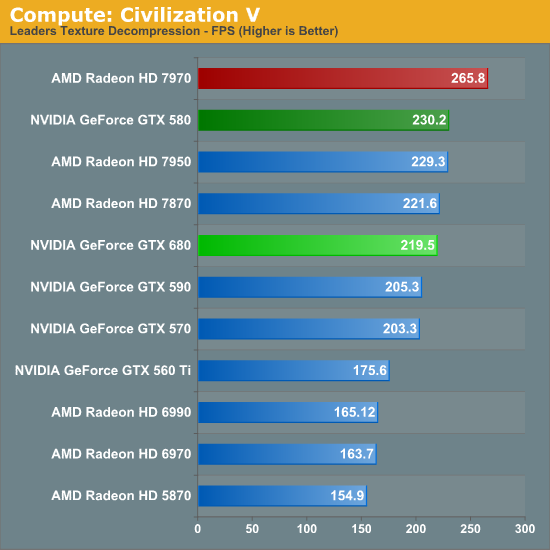
Remember when NVIDIA used to sweep AMD in Civ V Compute? Times have certainly changed. AMD’s shift to GCN has rocketed them to the top of our Civ V Compute benchmark, meanwhile the reality is that in what’s probably the most realistic DirectCompute benchmark we have has the GTX 680 losing to the GTX 580, never mind the 7970. It’s not by much, mind you, but in this case the GTX 680 for all of its functional units and its core clock advantage doesn’t have the compute performance to stand toe-to-toe with the GTX 580.
At first glance our initial assumptions would appear to be right: Kepler’s scheduler changes have weakened its compute performance relative to Fermi.
Our next benchmark is SmallLuxGPU, the GPU ray tracing branch of the open source LuxRender renderer. We’re now using a development build from the version 2.0 branch, and we’ve moved on to a more complex scene that hopefully will provide a greater challenge to our GPUs.
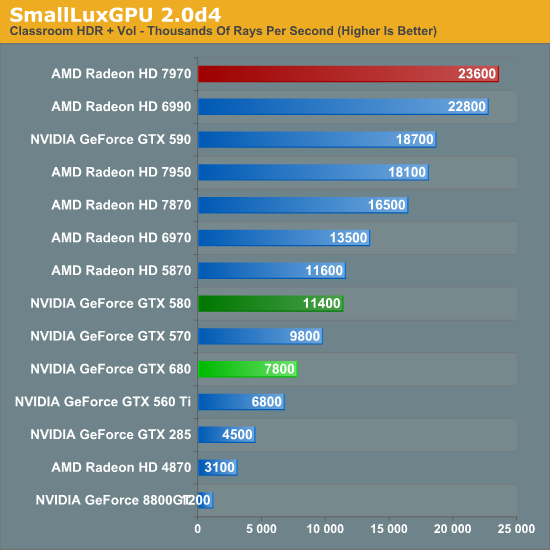
CivV was bad; SmallLuxGPU is worse. At this point the GTX 680 can’t even compete with the GTX 570, let alone anything Radeon. In fact the GTX 680 has more in common with the GTX 560 Ti than it does anything else.
On that note, since we weren’t going to significantly change our benchmark suite for the GTX 680 launch, NVIDIA had a solid hunch that we were going to use SmallLuxGPU in our tests, and spoke specifically of it. Apparently NVIDIA has put absolutely no time into optimizing their now all-important Kepler compiler for SmallLuxGPU, choosing to focus on games instead. While that doesn’t make it clear how much of GTX 680’s performance is due to the compiler versus a general loss in compute performance, it does offer at least a slim hope that NVIDIA can improve their compute performance.
For our next benchmark we’re looking at AESEncryptDecrypt, an OpenCL AES encryption routine that AES encrypts/decrypts an 8K x 8K pixel square image file. The results of this benchmark are the average time to encrypt the image over a number of iterations of the AES cypher.
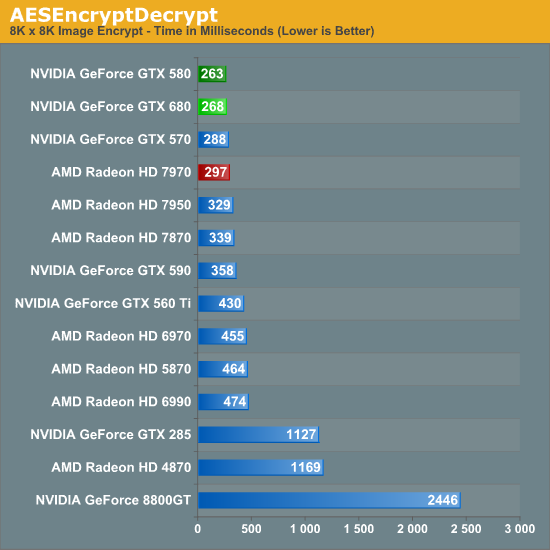
Starting with our AES encryption benchmark NVIDIA begins a recovery. GTX 680 is still technically slower than GTX 580, but only marginally so. If nothing else it maintains NVIDIA’s general lead in this benchmark, and is the first sign that GTX 680’s compute performance isn’t all bad.
For our fourth compute benchmark we wanted to reach out and grab something for CUDA, given the popularity of NVIDIA’s proprietary API. Unfortunately we were largely met with failure, for similar reasons as we were when the Radeon HD 7970 launched. Just as many OpenCL programs were hand optimized and didn’t know what to do with the Southern Islands architecture, many CUDA applications didn’t know what to do with GK104 and its Compute Capability 3.0 feature set.
To be clear, NVIDIA’s “core” CUDA functionality remains intact; PhysX, video transcoding, etc all work. But 3rd party applications are a much bigger issue. Among the CUDA programs that failed were NVIDIA’s own Design Garage (a GTX 480 showcase package), AccelerEyes’ GBENCH MatLab benchmark, and the latest Folding@Home client. Since our goal here is to stick to consumer/prosumer applications in reflection of the fact that the GTX 680 is a consumer card, we did somewhat limit ourselves by ruling out a number of professional CUDA applications, but there’s no telling that compatibility there would fare any better.
We ultimately started looking at Distributed Computing applications and settled on PrimeGrid, whose CUDA accelerated GENEFER client worked with GTX 680. Interestingly enough it primarily uses double precision math – whether this is a good thing or not though is up to the reader given the GTX 680’s anemic double precision performance.
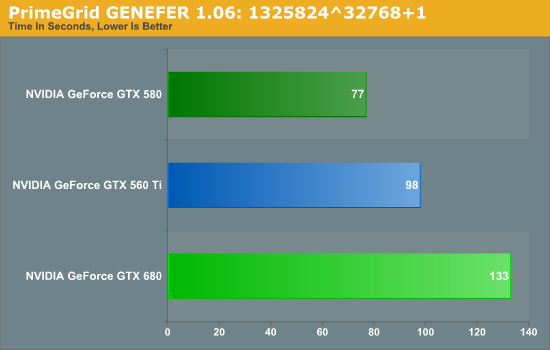
Because it’s based around double precision math the GTX 680 does rather poorly here, but the surprising bit is that it did so to a larger degree than we’d expect. The GTX 680’s FP64 performance is 1/24th its FP32 performance, compared to 1/8th on GTX 580 and 1/12th on GTX 560 Ti. Still, our expectation would be that performance would at least hold constant relative to the GTX 560 Ti, given that the GTX 680 has more than double the compute performance to offset the larger FP64 gap.
Instead we found that the GTX 680 takes 35% longer, when on paper it should be 20% faster than the GTX 560 Ti (largely due to the difference in the core clock). This makes for yet another test where the GTX 680 can’t keep up with the GTX 500 series, be it due to the change in the scheduler, or perhaps the greater pressure on the still-64KB L1 cache. Regardless of the reason, it is becoming increasingly evident that NVIDIA has sacrificed compute performance to reach their efficiency targets for GK104, which is an interesting shift from a company that was so gung-ho about compute performance, and a slightly concerning sign that NVIDIA may have lost faith in the GPU Computing market for consumer applications.
Finally, our last benchmark is once again looking at compute shader performance, this time through the Fluid simulation sample in the DirectX SDK. This program simulates the motion and interactions of a 16k particle fluid using a compute shader, with a choice of several different algorithms. In this case we’re using an (O)n^2 nearest neighbor method that is optimized by using shared memory to cache data.
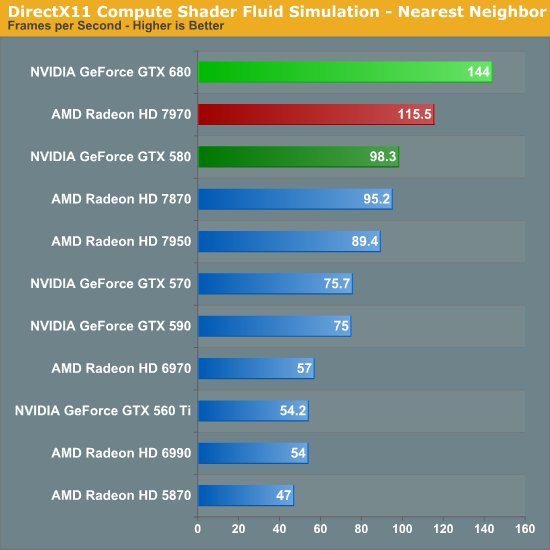
Redemption at last? In our final compute benchmark the GTX 680 finally shows that it can still succeed in some compute scenarios, taking a rather impressive lead over both the 7970 and the GTX 580. At this point it’s not particularly clear why the GTX 680 does so well here and only here, but the fact that this is a compute shader program as opposed to an OpenCL program may have something to do with it. NVIDIA needs solid compute shader performance for the games that use it; OpenCL and even CUDA performance however can take a backseat.










404 Comments
View All Comments
mm2587 - Thursday, March 22, 2012 - link
Well I guess we can expect AMD to slash price $50 across the top of their line to fall back into competition. Competion is always good for us consumers.While theres no arguing gtx680 looks like a great card I am a bit dissapointed this generation didn't push the boundries further on both the red and the green side. Hopefully gk100/gk110 is still brewing and we will still see a massive performance increase on the top end of the market this generation.
Unfortunatly I predict the gk100 is either scrapped or will be launched as a gtx 780 a year from now.
MarkusN - Thursday, March 22, 2012 - link
As far as I know, GK100 got scrapped due to issues but the GK110 is still cooking. ;)CeriseCogburn - Thursday, March 22, 2012 - link
Competition isn't "the same price with lesser features and lesser performance". I suppose with hardcore fanboys it is, but were talking about reality, and reality dictates the amd card needs to be at least $50 less than the 680..Lepton87 - Thursday, March 22, 2012 - link
http://translate.google.ca/translate?hl=en&sl=...So they are basically even at 2560 4xMSAA yet anand doesn't hesitate to call GTX680 indisputable king of the heel. It's strange because 7950 is at least the same amount faster than 580 yet he only implicitly said that it is faster than 580.
http://www.hardwarecanucks.com/forum...review-27.h...
http://www.guru3d.com/article/geforce-gtx-680-revi...
http://translate.google.ca/translate...itt_einleit...
judging from those results OC7970 is at least as fast if not faster than OC680. Wonder why they didn't directly compare oc numbers, probably this wasn't in nvidia reviewiers guide. Also it's not any better in tandem
http://www.sweclockers.com/recension...li/18#pageh...
Sabresiberian - Friday, March 23, 2012 - link
Someone needs to learn how to read charts.What, did you post a bunch of links and think no one was going to check them out?
I'll quote one of your sources, HardwareCanucks:
"After years of releasing inefficient, large and expensive GPUs, NVIDIA's GK104 core - and by association the GTX 680 - is not only smaller and less power hungry than Tahiti but it also outperforms the best AMD can offer by a substantial amount. "
Personally, I don't much care who comes out on top today, what I want is the battle for leadership to continue, for AMD and Nvidia to truly compete with each other, and not fall into some game of appearances.
"Big Kepler" should really establish how much better it is than Tahiti, though I wouldn't be surprised if some AMD fanboys will still turn the charts upside down and backwards to try to make Tahiti the leader - just as they are doing now. Of course, the 7990 dual GPU board will be out by then, and they will claim AMD has the best architecture based on it performing better than Big Kepler (assuming it does).
I don't know what AMD has planned, but I hope they come out with something right after Kepler (September? Too long, Nvidia, too long!) that is new, that will re-establish them. Of course, then there's Maxwell for next year . . .
;)
jigglywiggly - Thursday, March 22, 2012 - link
it's slower in crysis, it's slowerSabresiberian - Friday, March 23, 2012 - link
Yeah? What if it's faster in Crysis 2?http://www.tomshardware.com/reviews/geforce-gtx-68...
(While I get why using a venerable bench that Crysis provides gives us a performance base we're more familiar with, the marks for Crysis 2 show why an older model may not be such a good idea. Clearly, the GTX 680 beats out the Radeon 7970 in most DX9 benchmarks, and ALL DX11 Crysis 2 benches.)
So, your troll doesn't just fail, it epic fails.
SlyNine - Saturday, March 24, 2012 - link
My problem is the tests are run without AA. I'd rather seen some results with AA as I suspect that would cause the 680GTX to trade blows with the 7970.On the other hand 1920x1200 with 2x AA is AA enough for me.
HighTech4US - Thursday, March 22, 2012 - link
In the review all the slides are missing.For example: instead of a slide what is seen is this: [efficiency slide] or this [scheduler]
HighTech4US - Thursday, March 22, 2012 - link
OK, looks like it just got fixed